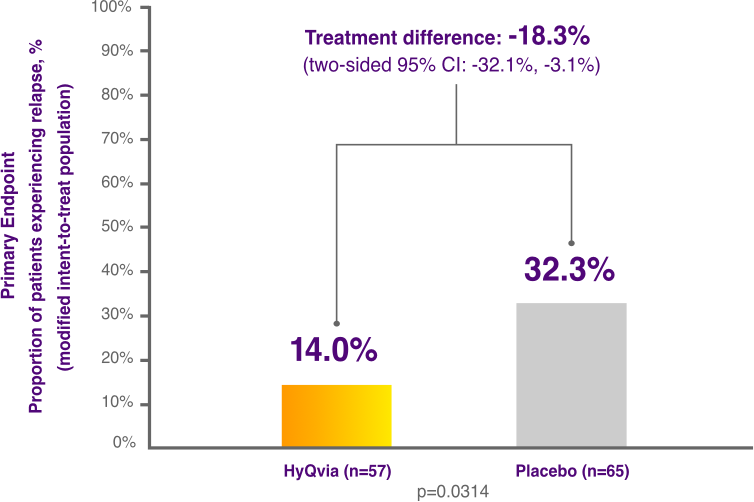
to proven relapse prevention as a maintenance therapy in adults
IG=Immune Globulin (Human), 10%; Hy=Recombinant Human Hyaluronidase
Study designs
ADVANCE-11
ADVANCE-1 (Study 1) was a phase 3, prospective, randomized, double-blind, multicenter, placebo-controlled study to investigate HyQvia as a maintenance therapy to prevent relapse of CIDP. Adults with definite/probable CIDP, an INCAT disability score of 0-7 (inclusive), and who were on a stable dose of IVIG for ≥12 weeks before screening were randomized and transitioned to HyQvia (n=62) or placebo (n=70).
- The starting dose and dosing frequency was the same as the subject’s previous IVIG treatment
- The mean monthly equivalent dose was 1.1 g/kg. Median duration of exposure was 5.3 months in the HyQvia group and 4.7 months in the placebo group
- Relapse was defined as worsening of functional disability characterized by an increase of ≥1 point relative to baseline in adjusted INCAT disability score performed at two timepoints <7 days apart. Primary efficacy analyses were conducted in the modified intention-to-treat set (all randomized patients who received any double-blind medication) and compared relapse rates using a continuity-corrected X2 test conducted at the 5% level of statistical significance
>90% (86*/94) of patients who completed ADVANCE-1 without CIDP worsening or relapse chose to enroll in ADVANCE-32
*A total of 86 patients were enrolled in ADVANCE-3. One patient was subsequently excluded for not meeting all eligibility criteria, resulting in 85 patients included in the study population. Out of the 85 patients in the final ADVANCE-3 analysis, 43 were from the patient group previously infused with HyQvia and 42 were from the placebo group now infusing with HyQvia.3
ADVANCE-31-3
ADVANCE-3 (Study 2) was a phase 3b, single-arm, open-label, multicenter extension of ADVANCE-1 to assess long-term safety, tolerability, and immunogenicity of HyQvia for maintenance therapy for CIDP. It followed subjects who completed ADVANCE-1 without CIDP worsening or relapse.
- The dosing range was 0.4 g/kg to 2.4 g/kg, given in a frequency of 2-, 3-, or 4-week intervals
- All subjects entering ADVANCE-3† continued to receive at the same dose and dosing interval as their full dose received in ADVANCE-1
- Placebo-treated subjects who did not have worsened CIDP during Study 1 were identified when the data were unblinded, and they were discontinued following unblinding of ADVANCE-1 treatment allocation
- An interim analysis, dated October 24, 2022, was performed. The data included 79 subjects with a range of follow-ups from 0 to 5.1 years and a total follow-up of 169 patient-years. A total of 2590 HyQvia infusions were administered
- A final analysis, last subject completed July 03, 2023, presenting results of the full study, inclusive of data previously reported in the interim analysis, included 78 subjects with a range of follow-ups from 0 to 6.4 years (median 33 months) and a total follow-up of 200.691 patient-years. A total of 3487 HyQvia infusions were administered
CIDP=chronic inflammatory demyelinating polyneuropathy; INCAT=Inflammatory Neuropathy Cause and Treatment; IVIG=intravenous immune globulin.
†Patients from the HyQvia arm of the ADVANCE-1 study continued the same dose regimen.3
Time to relapse* data for HyQvia in CIDP
No definitive conclusions or statistical claims can be drawn from the data below
ADVANCE-11
SECONDARY ENDPOINT

ADVANCE-1 was a
randomized, placebo-
controlled study.
Prespecified endpoint analyses were not
controlled for multiplicity.
ADVANCE-3 FINAL EXPLORATORY ENDPOINT3
Endpoints from ADVANCE-3, a single-arm open-label extension safety study, were assessed as exploratory data. The study included patients from both the HyQvia and placebo arms of the ADVANCE-1 trial. Different treatment exposures may have influenced outcomes. No definitive conclusions or statistical claims can be drawn from the data below.
Of those who relapsed in ADVANCE-3, the mean (SD) time to relapse was 939.8 (566.0) days (n=70).
It was not possible to estimate the median time to relapse for subjects because the censoring rate was very high and fewer than 50% of subjects relapsed.
SD=standard deviation.
*Time to relapse was calculated as: Date of relapse – date of initial dose of treatment + 1. Patients who did not relapse were censored with time to censoring calculated as:
Date of discontinuation or completion – date of initial treatment + 1.3,4
R-ODS* data for HyQvia in CIDP (activities of daily living)1
No definitive conclusions or statistical claims can be drawn from the data below
ADVANCE-11,5†
SECONDARY ENDPOINT
-1.2
HyQvia (n=57)
Baseline - mean (SD)‡: 63.5 (19.26)
End of study - mean (SD)§: 62.4 (20.12)
LS mean treatment
difference: 5:1
-6.3
Placebo (n=64)
Baseline - mean (SD)‡: 57.3 (15.44)
End of study - mean (SD)§: 51.9 (18.11)
ADVANCE-1 was a randomized, placebo-controlled study. Prespecified endpoint analyses were not controlled for multiplicity.
ADVANCE-3 FINAL EXPLORATORY ENDPOINT3
+0.7 mean change from baselineII (62.1) in R-ODS score to final¶ ADVANCE-3 open-label extension (63.0) (n=70; SDs: 17.79 and 18.16, respectively).
Endpoints from ADVANCE-3, a single-arm open-label extension safety study, were assessed as exploratory data. The study included patients from both the HyQvia and placebo arms of the ADVANCE-1 trial. Different treatment exposures may have influenced outcomes. No definitive conclusions or statistical claims can be drawn from the data above.
ANCOVA=analysis of covariance; LS=least squares; R-ODS=Rasch-built Overall Disability Scale; SD=standard deviation
*The R-ODS score, used to assess activities of daily living, was a centile metric with lower scores reflecting more severe limitations. LS mean is from an ANCOVA model with the last non-missing change from pre-SC baseline in
R-ODS total score as the outcome, treatment group and baseline R-ODS total score as a covariate.5
†Modified intent-to-treat analysis set includes all randomized subjects who received any double-blind investigational product.5
‡Baseline value is defined as the pre-SC treatment baseline visit value, if non-missing. If missing, then the screening visit value is used (if non-missing).5
§Study termination timepoint is defined as last non-missing post baseline record.5
IIBaseline value is defined as grip strength assessment at end of study visit in ADVANCE-1 with non-missing values. If no value is available from the baseline visit, then the most recent non-missing measurement prior to first dose of HyQvia in ADVANCE-3 and after last HyQvia dose in ADVANCE-1 is used.3
¶Study termination timepoint includes the last assessment performed on or after the end of treatment visit.3
Grip strength* data overview3,6
No definitive conclusions or statistical claims can be drawn from the data below
ADVANCE-1 PRESPECIFIED EXPLORATORY ENDPOINT6†
Mean change from baseline in maximum hand grip strength of the more affected hand:
+5.9 kPa
mean change in grip strength from baseline‡ (55.4, n=57) to end of study§ (62.0, n=55) with HyQvia
+2.0 kPa
mean change in grip strength from baseline‡ (54.5, n=64) to end of study§ (56.5, n=64) with placebo
There is no statistically significant difference between the two groups.
ADVANCE-1 was a randomized, placebo-controlled study. Prespecified endpoint analyses were not controlled for multiplicity, therefore no definitive conclusions or statistical claims can be drawn from this data.
ADVANCE-3 FINAL EXPLORATORY ENDPOINT3
Mean change from baseline in maximum hand grip strength of the more affected hand:
-2.5 kPa
mean change in grip strength from baselineII (66.5, n=78) to end of study¶ (61.8, n=64) with HyQvia
Endpoints from ADVANCE-3, a single-arm open-label extension safety study, were assessed as exploratory data. The study included patients from both the HyQvia and placebo arms of the ADVANCE-1 trial. Different treatment exposures may have influenced outcomes. No definitive conclusions or statistical claims can be drawn from the data above.
kPa=kilopascal
*Hand grip strength was assessed using a Vigorimeter and a maximum of three measurements per hand were taken at each study visit.3,6
†Modified intent-to-treat analysis set includes all randomized subjects who received any double-blind investigational product.6
‡Baseline value is defined as the pre-SC treatment baseline visit value, if non-missing. If missing, then the screening visit value is used (if non-missing).6
§Study termination timepoint is defined as last non-missing post baseline record.6
IIBaseline value is defined as grip strength assessment at end of study visit in ADVANCE-1 with non-missing values. If no value is available from the baseline visit, then the most recent non-missing measurement prior to first dose of HyQvia in ADVANCE-3 and after last HyQvia dose in ADVANCE-1 is used.3
¶Study termination timepoint includes the last assessment performed on or after the end of treatment visit.3
Talk to a representative
Get answers to your questions about HyQvia
References
- HyQvia. Prescribing information. Takeda Pharmaceuticals U.S.A., Inc.; 2025.
- Hadden RDM, Andersen H, Bril V, et al. Long-term safety and tolerability of hyaluronidase-facilitated subcutaneous immunoglobulin 10% as maintenance therapy for chronic inflammatory demyelinating polyradiculoneuropathy: Results from the ADVANCE-CIDP 3 trial. J Peripher Nerv Syst. 2024;29(4):441-452. doi:10.1111/jns.12672.
- ADVANCE-3 Data on File.
- Bril V, Hadden RDM, Brannagan TH 3rd, et al. Hyaluronidase-facilitated subcutaneous immunoglobulin 10% as maintenance therapy for chronic inflammatory demyelinating polyradiculoneuropathy: The ADVANCE-CIDP 1 randomized controlled trial. J Peripher Nerv Syst. 2023;28(3):436-449. doi:10.1111/jns.12573.
- HyQvia Data on File. CIDP ADVANCE-1 R-ODS Baseline and End of Treatment Data Exclude 1 Site.
- ADVANCE-1 Data on File.

 , and
, and